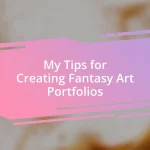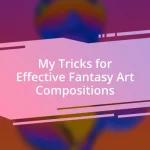Key takeaways:
- Mixing traditional and digital art techniques enhances creativity, allowing artists to experiment freely and produce unique textures that blend both mediums.
- Practical tips for blending styles include keeping a sketchbook for initial ideas, using traditional work as a base for digital enhancements, and exploring various software for experimentation.
- Showcasing mixed media work through cohesive displays and sharing the creative process on social media fosters deeper connections with audiences and opens up opportunities for engagement.

Understanding Traditional Art Methods
Traditional art methods encompass a broad spectrum of techniques that have been honed over centuries. For instance, think about the serenity of painting with oils—there’s something magical about the way the colors blend on the canvas. I vividly recall the first time I embraced this medium; the scent of the oil paint and the texture of the canvas seemed to awaken a part of my creative spirit that had been dormant.
Drawing, with its simplicity and immediate connection to the artist’s hand, offers an unparalleled form of expression. Sometimes I wonder: can anything rival the satisfaction of seeing your pencil glide across the page, capturing a moment in time? Those quiet afternoons spent sketching in the park taught me that traditional methods not only serve as tools but also as gateways to understanding oneself and the world around us.
Exploring methods like printmaking and watercolor reveals the unique qualities each medium brings. Consider printmaking, where the process of carving and inking can be both time-consuming and rewarding—just like life, every step contributes to the final piece. There’s a certain thrill in pulling that first print; it’s a tangible representation of your effort and intention, isn’t it? Each pull of the press carries with it the weight of history, reminding us that these practices are as much about the journey as they are about the end result.

Exploring Digital Art Techniques
Exploring digital art techniques brings together creativity and technology in a way that feels like magic. I remember the first time I tried my hand at digital painting. The ease of experimenting with colors and brushes on a screen was exhilarating—no messy cleanup required! It allowed me to let my imagination run wild without the limitations that traditional mediums sometimes impose.
One fascinating aspect of digital art is its versatility. Techniques like vector art and 3D modeling open up a world of possibilities. I once spent an entire weekend diving into 3D software, sculpting characters from scratch. It felt like building a tiny universe right at my fingertips! This method not only challenges one’s artistic eye but also teaches skills that are increasingly in demand in the design industry.
I often find myself blending different techniques, such as using digital tools to enhance traditional sketches. This fusion creates a dynamic experience that honors both worlds. There’s a thrill in editing my scanned pencil drawings digitally, as I layer colors and effects to breathe new life into them. It’s like adding a new chapter to a familiar story, merging my past experiences as an artist with present-day capabilities.
| Traditional Art Techniques | Digital Art Techniques |
|---|---|
| Hands-on methods, like oil painting and watercolor | Software-based approaches, such as Adobe Photoshop or Procreate |
| Requires physical materials and setup | Accessible with just a tablet or computer |
| Immediate tactile feedback and unique textures | Endless possibilities for manipulation and experimentation |

Benefits of Mixing Both Approaches
Mixing traditional and digital approaches offers a wealth of benefits that can truly elevate an artist’s work. I’ve often found that when I start with a traditional sketch, it grounds me in the physicality of art. The experience of the pencil in my hand connects me back to the core of my creativity. Then, when I transition to digital tools, it feels like I’m breathing new life into those sketches, adding layers that I couldn’t have achieved otherwise. This combination not only enriches my work but also allows for a seamless flow between tactile and technological exploration.
Here’s a breakdown of the benefits:
- Enhanced Creativity: Traditional methods spark a sense of creativity, while digital tools offer endless experimentation without the mess.
- Unique Texture Fusion: The tangible quality of traditional work combined with the slick finish of digital editing creates an intriguing visual contrast.
- Skill Development: Learning both mediums improves versatility and prepares artists for a variety of projects.
- Broadened Audience: Combining styles often appeals to a diverse audience, fostering connections with both traditional and contemporary art enthusiasts.
In my own experience, I appreciate how this blend can lead to unexpected breakthroughs. I remember a project where I painted a landscape and then digitally enhanced it with vibrant colors and surreal elements. The whole process was exhilarating! It felt like I was recreating the landscape in my mind rather than just on canvas. Mixing these approaches has transformed my artistic journey; each style complements the other, creating pieces that resonate deeply.

Practical Tips for Blending Styles
When I first started blending traditional and digital styles, one practical tip I stumbled upon was to keep a sketchbook handy for initial ideas. I often take a few moments each day to fill the pages with random sketches. It’s all about capturing that raw creativity, which I find so invigorating. This rawness can then evolve into something digital, where I incorporate tools like layers and filters to add depth. Doesn’t that feel liberating?
One of my favorite techniques is to use my traditional work as a base for my digital creations. For instance, when I completed a watercolor painting, I scanned it into my computer and added digital enhancements. I vividly recall how the colors popped even more when I played around with saturation levels. It highlighted the beauty of traditional mediums while breathing new life into them digitally. This process creates a dialogue between the two styles, doesn’t it?
Experimenting with different software is another critical element. I take time to explore various programs like Clip Studio Paint, which is great for illustrations, or Krita for its painting tools. Each product has its unique features that encourage playful experimentation. My journey led me to design an entire character in a 3D workspace—a step away from my usual process, but it brought so much joy and a unique perspective to my skills! If you’re willing to dip your toes into various platforms, the discoveries can enhance your creative voice remarkably.

Showcasing Your Mixed Media Work
When it comes to showcasing mixed media work, I love the idea of creating a cohesive display that tells a story. I remember curating my first exhibition where I combined traditional paintings with digital prints. It became clear to me that the juxtaposition of textures captivated the audience. I found that explaining the creative process behind each piece fostered a deeper connection, making the experience truly memorable for everyone involved. Have you ever considered how sharing your journey can transform a viewer’s perspective?
I also believe that using social media platforms to share snippets of my process can ignite incredible interest. For instance, posting time-lapse videos of my work evolving from traditional sketches to polished digital art has been a game changer. Viewers love seeing the transformation, and it has opened doors for conversations about the mixed media approach. It’s fascinating how people resonate with vulnerability in the creative process—don’t you think that sharing those little victories makes the art feel more approachable?
In my adventures in mixed media, I’ve discovered the importance of presenting the work in various formats. After finishing a piece, I often create a digital portfolio that showcases high-quality images, along with details about the techniques used. This method not only helps in professional presentations but also aids in building my personal brand as an artist. It’s exciting to think that every piece can lead to new opportunities, right? The more versatile our showcases, the more we can engage and inspire a diverse audience.

Learning from Successful Artists
It’s truly inspiring to look at successful artists who blend traditional and digital mediums. One artist I admire, for example, often sketches out her ideas on paper before transferring them into a digital format. Watching her process was enlightening; I remember asking her what the appeal was, and she said, “It’s where the magic happens.” Hearing that made me realize just how much value there is in those raw, initial sketches.
My journey also involved studying artists like James Jean, who’s a master at interweaving digital enhancements with traditional art. I once experimented with incorporating elements from his style into my own, and it felt like stepping into a new world of creativity. What I found fascinating was how Jean’s layering of textures brought depth to his narrative. It made me question how I could enhance my own storytelling through mixed media, and I began to see my work in a different light.
Moreover, I’ve noticed that many successful artists often reach out to their audience for feedback. When I shared a rough draft of a digital illustration on social media, the supportive comments and constructive criticism I received helped refine my vision. It was a reminder of the community’s role in my growth—doesn’t collaboration amplify creativity? Those experiences taught me that learning from others, while staying true to my own voice, can lead to astonishing breakthroughs.














